Qin Zou
CogNav: Cognitive Process Modeling for Object Goal Navigation with LLMs
Dec 11, 2024Abstract:Object goal navigation (ObjectNav) is a fundamental task of embodied AI that requires the agent to find a target object in unseen environments. This task is particularly challenging as it demands both perceptual and cognitive processes for effective perception and decision-making. While perception has gained significant progress powered by the rapidly developed visual foundation models, the progress on the cognitive side remains limited to either implicitly learning from massive navigation demonstrations or explicitly leveraging pre-defined heuristic rules. Inspired by neuroscientific evidence that humans consistently update their cognitive states while searching for objects in unseen environments, we present CogNav, which attempts to model this cognitive process with the help of large language models. Specifically, we model the cognitive process with a finite state machine composed of cognitive states ranging from exploration to identification. The transitions between the states are determined by a large language model based on an online built heterogeneous cognitive map containing spatial and semantic information of the scene being explored. Extensive experiments on both synthetic and real-world environments demonstrate that our cognitive modeling significantly improves ObjectNav efficiency, with human-like navigation behaviors. In an open-vocabulary and zero-shot setting, our method advances the SOTA of the HM3D benchmark from 69.3% to 87.2%. The code and data will be released.
Stacking Brick by Brick: Aligned Feature Isolation for Incremental Face Forgery Detection
Nov 19, 2024



Abstract:The rapid advancement of face forgery techniques has introduced a growing variety of forgeries. Incremental Face Forgery Detection (IFFD), involving gradually adding new forgery data to fine-tune the previously trained model, has been introduced as a promising strategy to deal with evolving forgery methods. However, a naively trained IFFD model is prone to catastrophic forgetting when new forgeries are integrated, as treating all forgeries as a single ''Fake" class in the Real/Fake classification can cause different forgery types overriding one another, thereby resulting in the forgetting of unique characteristics from earlier tasks and limiting the model's effectiveness in learning forgery specificity and generality. In this paper, we propose to stack the latent feature distributions of previous and new tasks brick by brick, $\textit{i.e.}$, achieving $\textbf{aligned feature isolation}$. In this manner, we aim to preserve learned forgery information and accumulate new knowledge by minimizing distribution overriding, thereby mitigating catastrophic forgetting. To achieve this, we first introduce Sparse Uniform Replay (SUR) to obtain the representative subsets that could be treated as the uniformly sparse versions of the previous global distributions. We then propose a Latent-space Incremental Detector (LID) that leverages SUR data to isolate and align distributions. For evaluation, we construct a more advanced and comprehensive benchmark tailored for IFFD. The leading experimental results validate the superiority of our method.
Co-Fix3D: Enhancing 3D Object Detection with Collaborative Refinement
Aug 15, 2024Abstract:In the realm of autonomous driving,accurately detecting occluded or distant objects,referred to as weak positive sample ,presents significant challenges. These challenges predominantly arise during query initialization, where an over-reliance on heatmap confidence often results in a high rate of false positives, consequently masking weaker detections and impairing system performance. To alleviate this issue, we propose a novel approach, Co-Fix3D, which employs a collaborative hybrid multi-stage parallel query generation mechanism for BEV representations. Our method incorporates the Local-Global Feature Enhancement (LGE) module, which refines BEV features to more effectively highlight weak positive samples. It uniquely leverages the Discrete Wavelet Transform (DWT) for accurate noise reduction and features refinement in localized areas, and incorporates an attention mechanism to more comprehensively optimize global BEV features. Moreover, our method increases the volume of BEV queries through a multi-stage parallel processing of the LGE, significantly enhancing the probability of selecting weak positive samples. This enhancement not only improves training efficiency within the decoder framework but also boosts overall system performance. Notably, Co-Fix3D achieves superior results on the stringent nuScenes benchmark, outperforming all previous models with a 69.1% mAP and 72.9% NDS on the LiDAR-based benchmark, and 72.3% mAP and 74.1% NDS on the multi-modality benchmark, without relying on test-time augmentation or additional datasets. The source code will be made publicly available upon acceptance.
IDRetracor: Towards Visual Forensics Against Malicious Face Swapping
Aug 13, 2024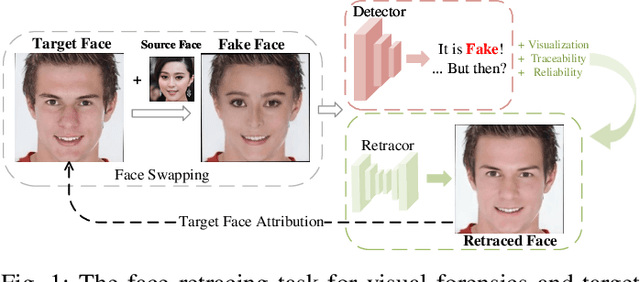
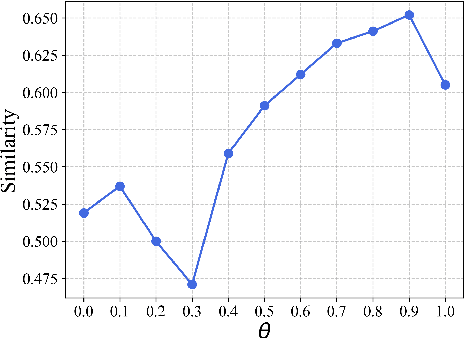
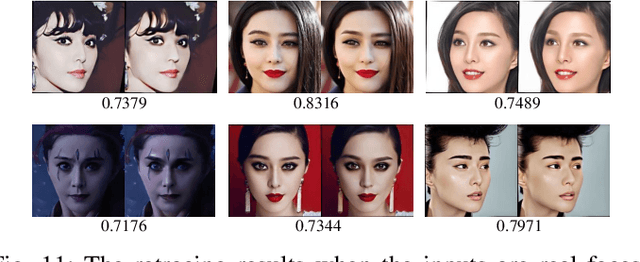
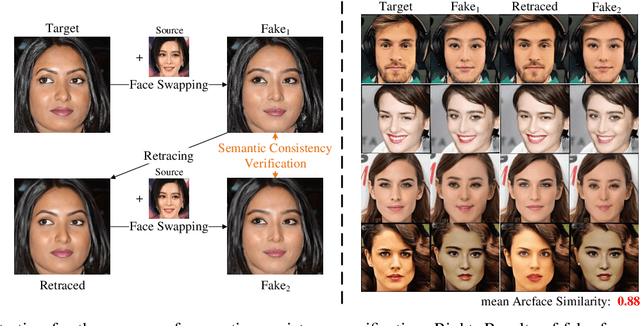
Abstract:The face swapping technique based on deepfake methods poses significant social risks to personal identity security. While numerous deepfake detection methods have been proposed as countermeasures against malicious face swapping, they can only output binary labels (Fake/Real) for distinguishing fake content without reliable and traceable evidence. To achieve visual forensics and target face attribution, we propose a novel task named face retracing, which considers retracing the original target face from the given fake one via inverse mapping. Toward this goal, we propose an IDRetracor that can retrace arbitrary original target identities from fake faces generated by multiple face swapping methods. Specifically, we first adopt a mapping resolver to perceive the possible solution space of the original target face for the inverse mappings. Then, we propose mapping-aware convolutions to retrace the original target face from the fake one. Such convolutions contain multiple kernels that can be combined under the control of the mapping resolver to tackle different face swapping mappings dynamically. Extensive experiments demonstrate that the IDRetracor exhibits promising retracing performance from both quantitative and qualitative perspectives.
ED$^4$: Explicit Data-level Debiasing for Deepfake Detection
Aug 13, 2024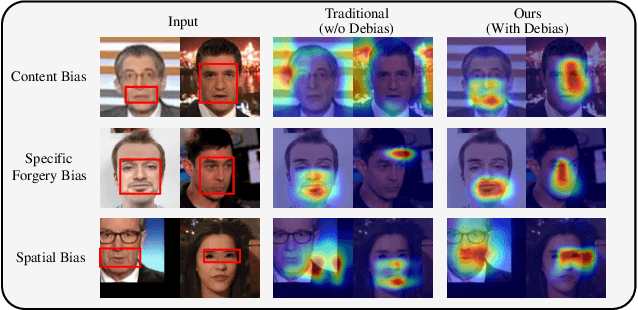
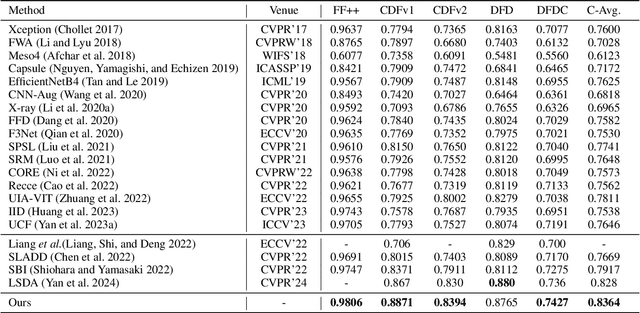
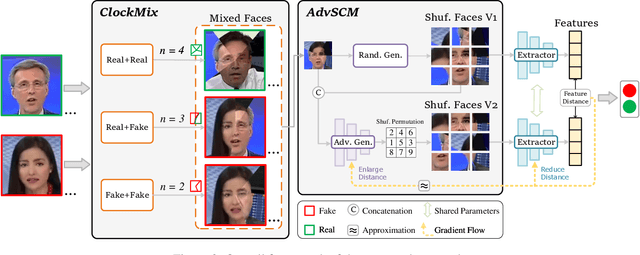

Abstract:Learning intrinsic bias from limited data has been considered the main reason for the failure of deepfake detection with generalizability. Apart from the discovered content and specific-forgery bias, we reveal a novel spatial bias, where detectors inertly anticipate observing structural forgery clues appearing at the image center, also can lead to the poor generalization of existing methods. We present ED$^4$, a simple and effective strategy, to address aforementioned biases explicitly at the data level in a unified framework rather than implicit disentanglement via network design. In particular, we develop ClockMix to produce facial structure preserved mixtures with arbitrary samples, which allows the detector to learn from an exponentially extended data distribution with much more diverse identities, backgrounds, local manipulation traces, and the co-occurrence of multiple forgery artifacts. We further propose the Adversarial Spatial Consistency Module (AdvSCM) to prevent extracting features with spatial bias, which adversarially generates spatial-inconsistent images and constrains their extracted feature to be consistent. As a model-agnostic debiasing strategy, ED$^4$ is plug-and-play: it can be integrated with various deepfake detectors to obtain significant benefits. We conduct extensive experiments to demonstrate its effectiveness and superiority over existing deepfake detection approaches.
NePF: Neural Photon Field for Single-Stage Inverse Rendering
Nov 20, 2023Abstract:We present a novel single-stage framework, Neural Photon Field (NePF), to address the ill-posed inverse rendering from multi-view images. Contrary to previous methods that recover the geometry, material, and illumination in multiple stages and extract the properties from various multi-layer perceptrons across different neural fields, we question such complexities and introduce our method - a single-stage framework that uniformly recovers all properties. NePF achieves this unification by fully utilizing the physical implication behind the weight function of neural implicit surfaces and the view-dependent radiance. Moreover, we introduce an innovative coordinate-based illumination model for rapid volume physically-based rendering. To regularize this illumination, we implement the subsurface scattering model for diffuse estimation. We evaluate our method on both real and synthetic datasets. The results demonstrate the superiority of our approach in recovering high-fidelity geometry and visual-plausible material attributes.
Domain Adaptation based Enhanced Detection for Autonomous Driving in Foggy and Rainy Weather
Jul 20, 2023Abstract:Typically, object detection methods for autonomous driving that rely on supervised learning make the assumption of a consistent feature distribution between the training and testing data, however such assumption may fail in different weather conditions. Due to the domain gap, a detection model trained under clear weather may not perform well in foggy and rainy conditions. Overcoming detection bottlenecks in foggy and rainy weather is a real challenge for autonomous vehicles deployed in the wild. To bridge the domain gap and improve the performance of object detectionin foggy and rainy weather, this paper presents a novel framework for domain-adaptive object detection. The adaptations at both the image-level and object-level are intended to minimize the differences in image style and object appearance between domains. Furthermore, in order to improve the model's performance on challenging examples, we introduce a novel adversarial gradient reversal layer that conducts adversarial mining on difficult instances in addition to domain adaptation. Additionally, we suggest generating an auxiliary domain through data augmentation to enforce a new domain-level metric regularization. Experimental findings on public V2V benchmark exhibit a substantial enhancement in object detection specifically for foggy and rainy driving scenarios.
S2R-ViT for Multi-Agent Cooperative Perception: Bridging the Gap from Simulation to Reality
Jul 18, 2023Abstract:Due to the lack of real multi-agent data and time-consuming of labeling, existing multi-agent cooperative perception algorithms usually select the simulated sensor data for training and validating. However, the perception performance is degraded when these simulation-trained models are deployed to the real world, due to the significant domain gap between the simulated and real data. In this paper, we propose the first Simulation-to-Reality transfer learning framework for multi-agent cooperative perception using a novel Vision Transformer, named as S2R-ViT, which considers both the Implementation Gap and Feature Gap between simulated and real data. We investigate the effects of these two types of domain gaps and propose a novel uncertainty-aware vision transformer to effectively relief the Implementation Gap and an agent-based feature adaptation module with inter-agent and ego-agent discriminators to reduce the Feature Gap. Our intensive experiments on the public multi-agent cooperative perception datasets OPV2V and V2V4Real demonstrate that the proposed S2R-ViT can effectively bridge the gap from simulation to reality and outperform other methods significantly for point cloud-based 3D object detection.
Coarse-to-fine Task-driven Inpainting for Geoscience Images
Dec 06, 2022



Abstract:The processing and recognition of geoscience images have wide applications. Most of existing researches focus on understanding the high-quality geoscience images by assuming that all the images are clear. However, in many real-world cases, the geoscience images might contain occlusions during the image acquisition. This problem actually implies the image inpainting problem in computer vision and multimedia. To the best of our knowledge, all the existing image inpainting algorithms learn to repair the occluded regions for a better visualization quality, they are excellent for natural images but not good enough for geoscience images by ignoring the geoscience related tasks. This paper aims to repair the occluded regions for a better geoscience task performance with the advanced visualization quality simultaneously, without changing the current deployed deep learning based geoscience models. Because of the complex context of geoscience images, we propose a coarse-to-fine encoder-decoder network with coarse-to-fine adversarial context discriminators to reconstruct the occluded image regions. Due to the limited data of geoscience images, we use a MaskMix based data augmentation method to exploit more information from limited geoscience image data. The experimental results on three public geoscience datasets for remote sensing scene recognition, cross-view geolocation and semantic segmentation tasks respectively show the effectiveness and accuracy of the proposed method.
Line Drawing Guided Progressive Inpainting of Mural Damages
Nov 12, 2022



Abstract:Mural image inpainting refers to repairing the damage or missing areas in a mural image to restore the visual appearance. Most existing image-inpainting methods tend to take a target image as the only input and directly repair the damage to generate a visually plausible result. These methods obtain high performance in restoration or completion of some specific objects, e.g., human face, fabric texture, and printed texts, etc., however, are not suitable for repairing murals with varied subjects, especially for murals with large damaged areas. Moreover, due to the discrete colors in paints, mural inpainting may suffer from apparent color bias as compared to natural image inpainting. To this end, in this paper, we propose a line drawing guided progressive mural inpainting method. It divides the inpainting process into two steps: structure reconstruction and color correction, executed by a structure reconstruction network (SRN) and a color correction network (CCN), respectively. In the structure reconstruction, line drawings are used by SRN as a guarantee for large-scale content authenticity and structural stability. In the color correction, CCN operates a local color adjustment for missing pixels which reduces the negative effects of color bias and edge jumping. The proposed approach is evaluated against the current state-of-the-art image inpainting methods. Qualitative and quantitative results demonstrate the superiority of the proposed method in mural image inpainting. The codes and data are available at {https://github.com/qinnzou/mural-image-inpainting}.
 Add to Chrome
Add to Chrome Add to Firefox
Add to Firefox Add to Edge
Add to Edge